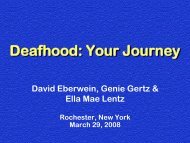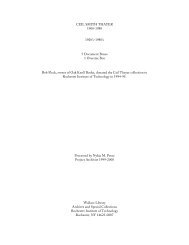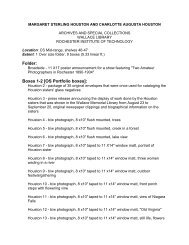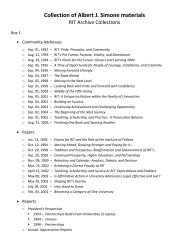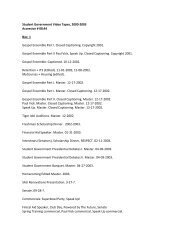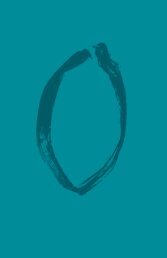Will Burtin Papers, c.1857-1972 - RIT Libraries - Rochester Institute ...
Will Burtin Papers, c.1857-1972 - RIT Libraries - Rochester Institute ...
Will Burtin Papers, c.1857-1972 - RIT Libraries - Rochester Institute ...
Create successful ePaper yourself
Turn your PDF publications into a flip-book with our unique Google optimized e-Paper software.
Biographical Note<br />
1908-1938<br />
Designer, art director, and teacher, <strong>Will</strong> <strong>Burtin</strong> was born in 1908 in Cologne,<br />
Germany. <strong>Burtin</strong> initially trained as a typographer and served as an apprentice in 1922. At<br />
night, he expanded his education into design by attending, and later teaching at the Cologne<br />
Werkschule. His successful design practice included the creation of exhibits and printed<br />
publications for industrial clients. By the late 30s, <strong>Burtin</strong>’s work had garnered so much<br />
attention in Germany, that he was approached by Hitler to design for the Nazis: “They were<br />
insidious. I couldn’t refuse and stay in Germany.” Fleeing with his wife, Hilde, <strong>Burtin</strong><br />
immigrated to the United States in 1938.<br />
1939-1948<br />
Quickly finding work, <strong>Burtin</strong> designed the Federal Works Exhibition for the United<br />
States Pavilion at the 1939 New York World’s Fair, and began teaching at the Pratt<br />
<strong>Institute</strong>. As a freelance designer, <strong>Burtin</strong> earned a medal from the New York Art Directors<br />
Club in 1941 for his cover design of Architectural Forum, and had an issue of A-D (vol. 8,<br />
no. 3) devoted entirely to his work from the previous decade. These would be the first of<br />
many honors awarded to <strong>Burtin</strong> over the course of his career.<br />
In 1943, <strong>Will</strong> <strong>Burtin</strong> was drafted into the US Army and spent the next three years<br />
designing gunnery manuals. This unique ability to visually express complex concepts<br />
would emerge as a defining characteristic of <strong>Burtin</strong>’s work. Years later, photographer Ezra<br />
Stoller cited this experience, along with <strong>Burtin</strong>’s background in typography and printing as<br />
helping to define his tenure as art director (1945-1949) of Fortune magazine:<br />
“The layouts suddenly invested Fortune with a new dimension. Copy and<br />
illustrations were not just neatly organized; they were presented as<br />
counterpoint to each other. Indeed, one could get the sense of a story by<br />
simply following the layout with the text acting as a clarification and<br />
reinforcement.”<br />
The mid to late 40s saw <strong>Burtin</strong> expand his role in professional organizations,<br />
serving as Director of the American <strong>Institute</strong> of Graphic Arts (AIGA). In 1948, <strong>Burtin</strong>’s<br />
Integration: The New Discipline in Design exhibit opened at the Composing Room in New<br />
York City. In the introduction to the exhibition, designer Serge Chermayeff stated:<br />
“This new art of ‘visualization,’ of giving visual form in two or three<br />
dimensions to a message, is the product of a new kind of artist functionary<br />
evolved by our complex society. This artist possesses the inclusive<br />
equipment of liberal knowledge, scientific and technical experience, and<br />
artisticability….Among the small band of pioneers who have developed this<br />
new language by bringing patient research and brilliant inventiveness to<br />
their task is <strong>Will</strong> <strong>Burtin</strong>.”<br />
<strong>Burtin</strong> papers, page 5


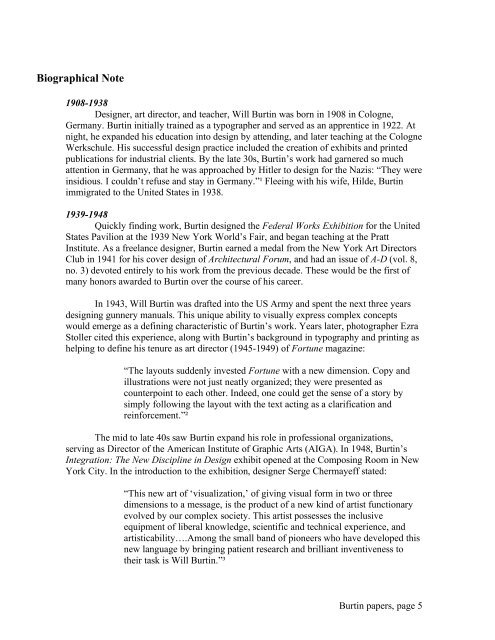

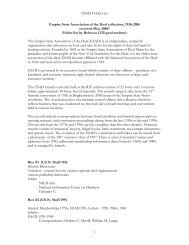
![A Conversation with Danny Glover & Joslyn Barnes [PDF]](https://img.yumpu.com/17810254/1/190x245/a-conversation-with-danny-glover-joslyn-barnes-pdf.jpg?quality=85)

